
DOFMaster
for Windows
On-line
Depth of Field
Calculator
DOFMaster for Mobile Devices
On-line
Depth of Field
Table
Hyperfocal
Distance Chart
Articles
FAQ
Recommended
Books
Support
Contact
Links
Home
for Windows
On-line
Depth of Field
Calculator
DOFMaster for Mobile Devices
On-line
Depth of Field
Table
Hyperfocal
Distance Chart
Articles
FAQ
Recommended
Books
Support
Contact
Links
Home
As an Amazon Associate I earn from qualifying purchases.
![]()
blacken the inside of the envelope and operates at an
almost constant brightness and color temperature
throughout its life. Tungsten-halogen lamps for
photography operate at color temperatures of 3200 K
daylight. For its size, a tungsten-halogen lamp generally
delivers more light than a conventional 3200 K lamp.
Tungsten-halogen lights are becoming more popular
and are rapidly replacing regular tungsten lights for
general photographic use.
however, they usually have a greenish cast. When a
tungsten type of color film is used with a fluorescent
lamp without a filter, the pictures usually are too blue.
different from either daylight or tungsten light.
Fluorescent lights have no true color temperature, but a
value of approximate color temperature has been
worked out.
predominant lights are fluorescent. Electronic flash uses
with a powerful charge of electricity from a capacitor.
that ionizes the gas. The output, or intensity of the flash,
is usually given in effective candlepower-seconds and
depends on the voltage and size of the capacitor. The
design of the reflector on an electronic flash has a direct
relationship on the efficiency of the unit.
films. The duration of the flash is short, usually 1/500
second or less. With a computerized (automatic) unit
used close to the subject, the flash duration can be as
units have a sensor that switches off the flash when the
subject (depending on its distance and tone) has received
enough light for proper exposure.
artificial light sources-tungsten, tungsten-halogen,
fluorescent, and electronic flash lamps to direct the light.
The second type, the plane reflector, is used to redirect
light from any kind of light source into shaded areas to
soften or lighten shadows. (While it is true that mirrors
are also reflectors, reflector is used in photography as a
more general term. Mirrors always reflect specular light;
and reflectors reflect either specular or diffused light.)
illuminating only a given area, and it is, therefore, to
almost all the light onto the area to be photographed
(fig. 1-13). Lamp reflectors generally have a satin or
matte finish to diffuse the reflected light to prevent hot
spots that could result if the reflector surface were highly
polished.
Basic Photography Course

As an Amazon Associate I earn from qualifying purchases.
WWW.DOFMASTER.COM
© 2006 Don Fleming. All rights reserved.
© 2006 Don Fleming. All rights reserved.